MITSUBISHI 3000GT 1991 Service Manual
Manufacturer: MITSUBISHI, Model Year: 1991, Model line: 3000GT, Model: MITSUBISHI 3000GT 1991Pages: 1146, PDF Size: 76.68 MB
Page 271 of 1146
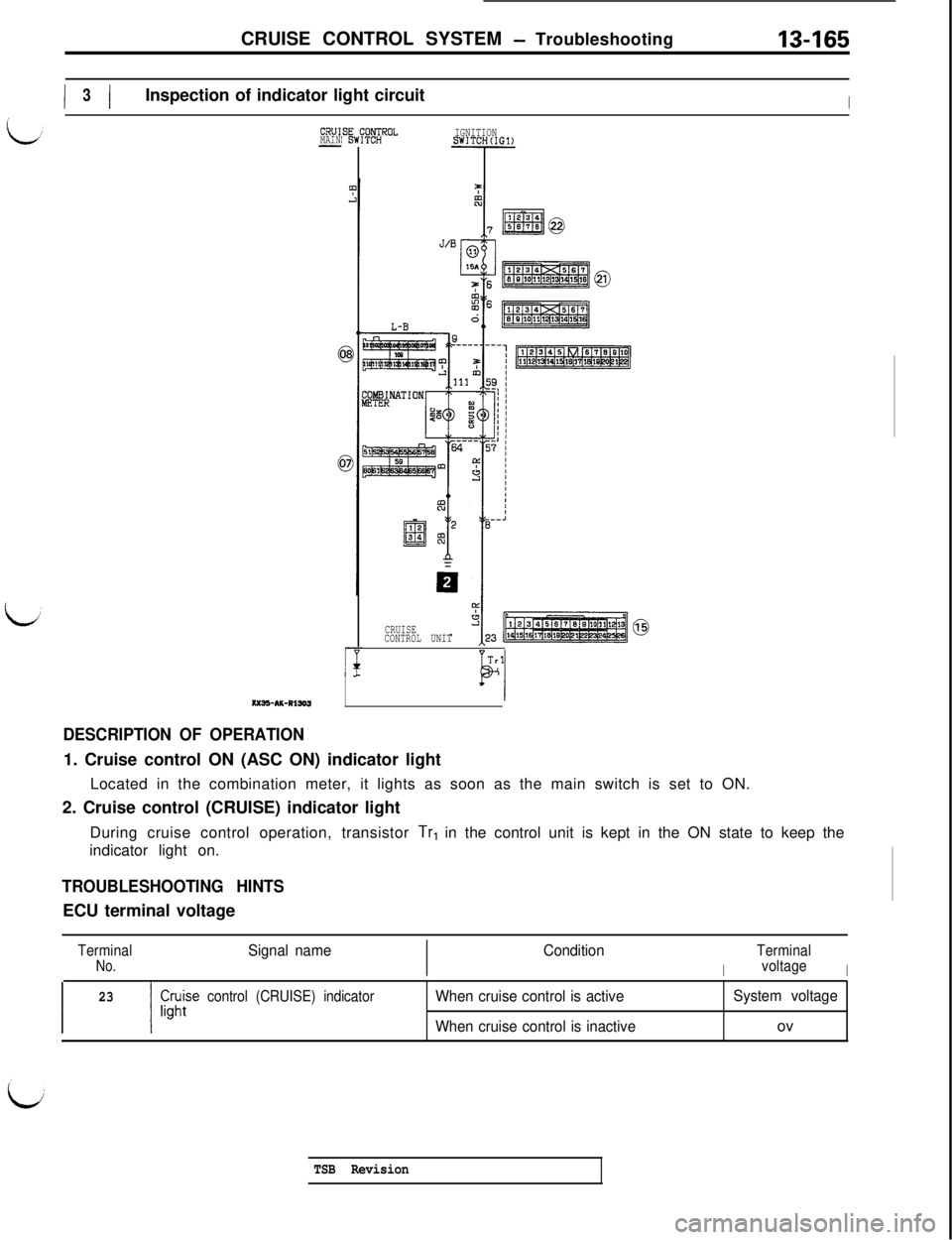
CRUISE CONTROL SYSTEM - Troubleshooting13-165
I I3Inspection of indicator light circuitI
CRUl
MAIN-!;$ROLIGNITIONSWITCH(IG1)
l-
CRUISE
CONTROL UNIT
Trl
b!XXSS-AK-RI303
DESCRIPTION OF OPERATION1. Cruise control ON (ASC ON) indicator light
Located in the combination meter, it lights as soon as the main switch is set to ON.
2. Cruise control (CRUISE) indicator light
During cruise control operation, transistor
Tr, in the control unit is kept in the ON state to keep the
indicator light on.
TROUBLESHOOTING HINTSECU terminal voltage
TerminalNo.Signal nameCondition
I
Terminal
voltage
I
23
I I
fr;se control (CRUISE) indicatorWhen cruise control is activeSystem voltage
When cruise control is inactiveov
TSB Revision
Page 272 of 1146
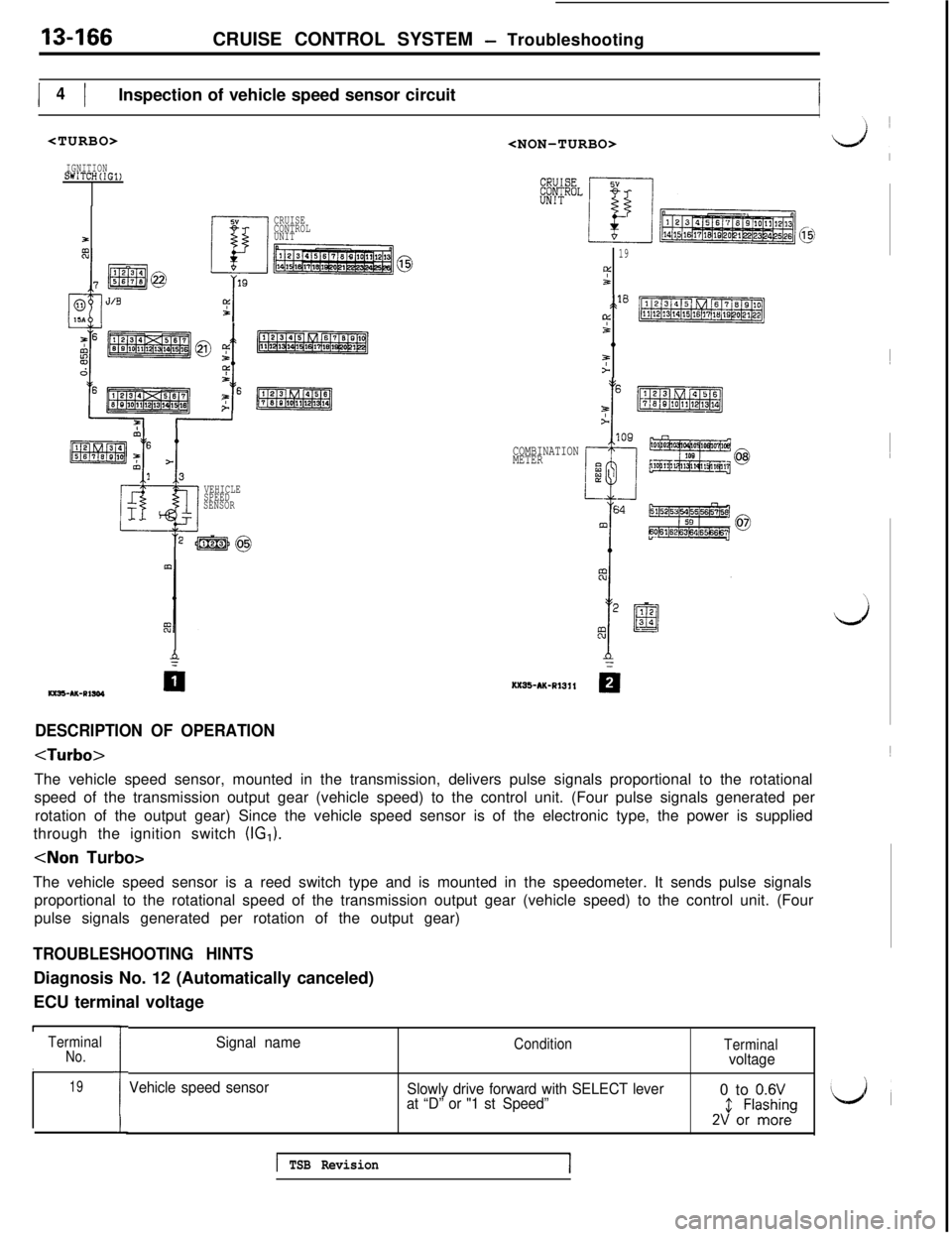
13466CRUISE CONTROL SYSTEM - Troubleshooting
I I4Inspection of vehicle speed sensor circuitI
IGNITIONSWITCH(IG1)
5”
El
CRUISE
CONTROL
3UNIT
cl!AI
g6pl!Ezq@zla
;i
d
“m ;ygmq%q
?
VEHICLE
SPEED
SENSOR
xX35-AR-RI304P
19Y
*
$
&
~E$iJ
0z
L
COMBINATION
METER
KX35-AK-Rl3Yla
DESCRIPTION OF OPERATION
The vehicle speed sensor, mounted in the transmission, delivers pulse signals proportional to the rotational
speed of the transmission output gear (vehicle speed) to the control unit. (Four pulse signals generated per
rotation of the output gear) Since the vehicle speed sensor is of the electronic type, the power is supplied
through the ignition switch (IG,).
The vehicle speed sensor is a reed switch type and is mounted in the speedometer. It sends pulse signals
proportional to the rotational speed of the transmission output gear (vehicle speed) to the control unit. (Four
pulse signals generated per rotation of the output gear)
TROUBLESHOOTING HINTSDiagnosis No. 12 (Automatically canceled)
ECU terminal voltage
1TerminalNo.I19
i
Signal nameCondition
Terminalvoltage
Vehicle speed sensor
Slowly drive forward with SELECT lever0 to
0.6Vat “D” or "1 st Speed”2J &l;;:neg
1 TSB RevisionI
LjlI~~
\
J1
l/j,
Page 273 of 1146
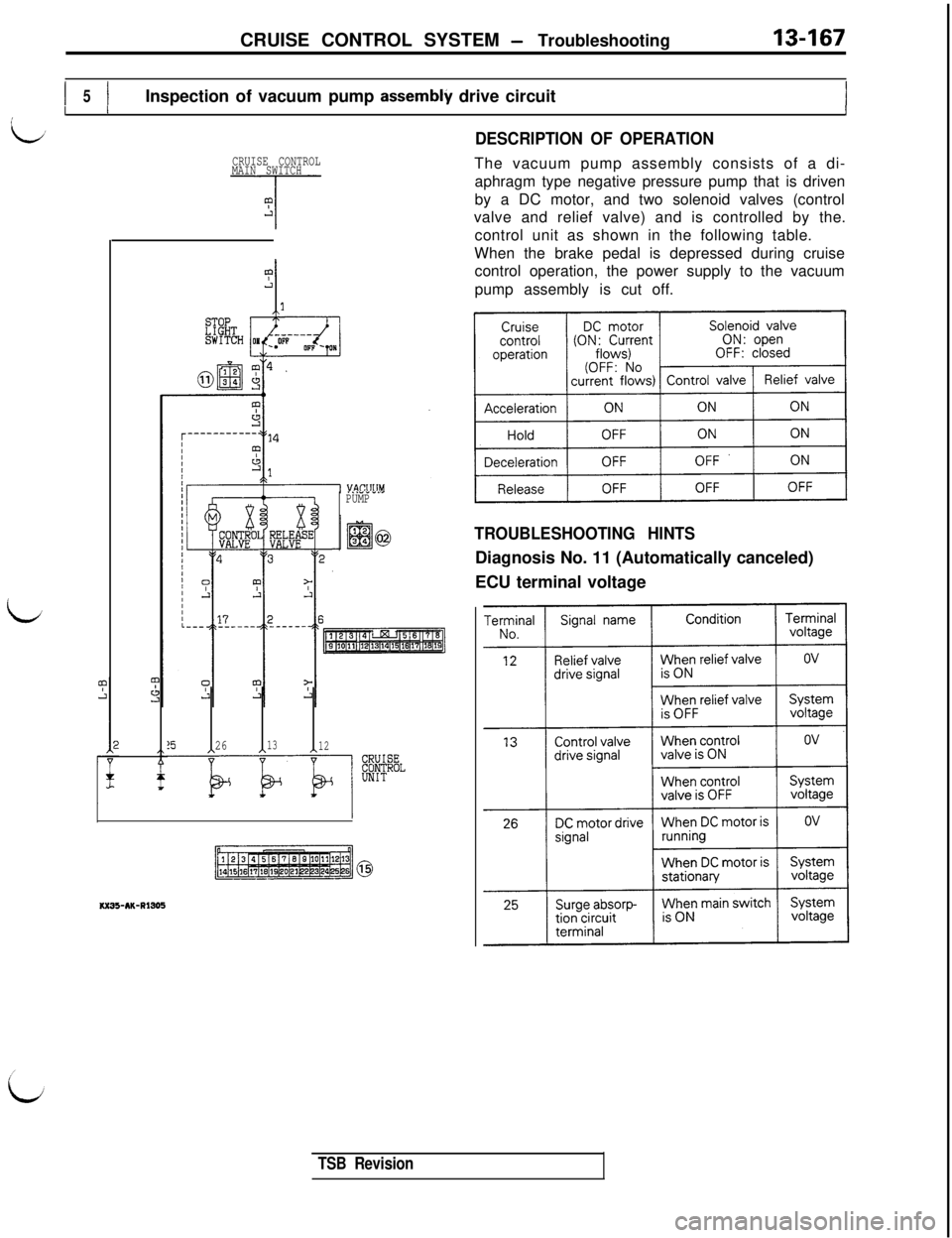
CRUISE CONTROL SYSTEM - Troubleshooting13-167
I I5Inspection of vacuum pump assemblv drive circuitIIII
id
CRUISE CONTROL
MAIN SWITCH
l-
4-'a
1.1-111.PUMP
@
!52613
12
KK33-AK-R1905
DESCRIPTION OF OPERATIONThe vacuum pump assembly consists of a di-
aphragm type negative pressure pump that is driven
by a DC motor, and two solenoid valves (control
valve and relief valve) and is controlled by the.
control unit as shown in the following table.
When the brake pedal is depressed during cruise
control operation, the power supply to the vacuum
pump assembly is cut off.
TROUBLESHOOTING HINTSDiagnosis No. 11 (Automatically canceled)
ECU terminal voltage
TSB Revision
Page 274 of 1146
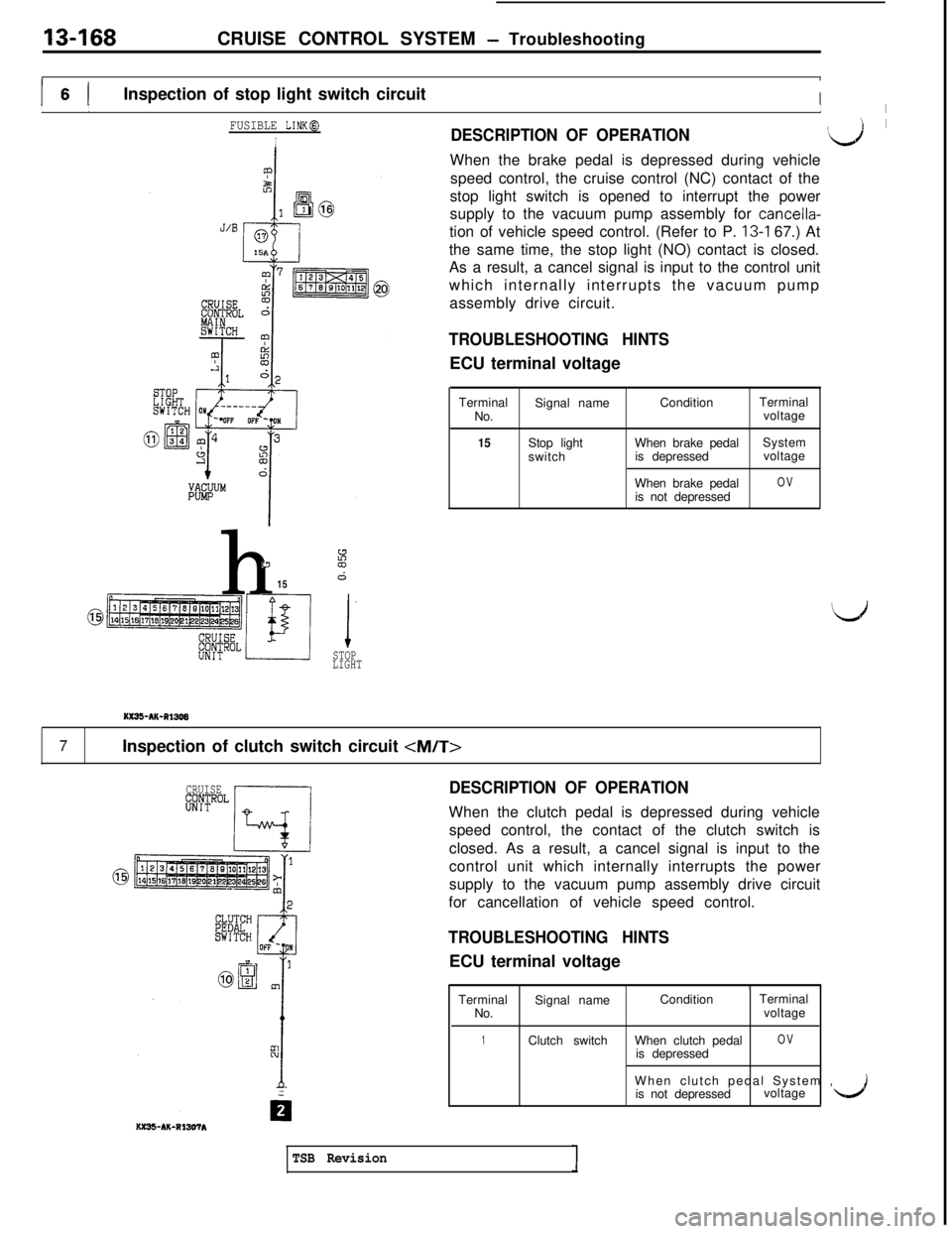
13-168CRUISE CONTROL SYSTEM - Troubleshooting,I
I 6 IInspection of stop light switch circuitIIIII
FUSIBLE LINK@
IDESCRIPTION OF OPERATIONIJ iWhen the brake pedal is depressed during vehicle
speed control, the cruise control (NC) contact of the
stop light switch is opened to interrupt the power
supply to the vacuum pump assembly for
cancella-tion of vehicle speed control. (Refer to P. 13-I 67.) At
the same time, the stop light (NO) contact is closed.
As a result, a cancel signal is input to the control unit
which internally interrupts the vacuum pump
assembly drive circuit.
TROUBLESHOOTING HINTSECU terminal voltage
Terminal
No.Signal nameConditionTerminal
voltage
15Stop light
switchWhen brake pedal
is depressedSystem
voltage
When brake pedal
is not depressed
OVh
”z15d
El 1’STOP
LIGHT
xx35-AX-R1305
7Inspection of clutch switch circuit
CRUISEc!$;ROLDESCRIPTION OF OPERATIONWhen the clutch pedal is depressed during vehicle
speed control, the contact of the clutch switch is
closed. As a result, a cancel signal is input to the
control unit which internally interrupts the power
supply to the vacuum pump assembly drive circuit
for cancellation of vehicle speed control.
TROUBLESHOOTING HINTSECU terminal voltage
II,Terminal
Signal nameConditionTerminal
No.voltage
1Clutch switchWhen clutch pedalOVis depressed
When clutch pedal System ,
is not depressedvoltage
d
KK35-AK-R130TA
TSB Revision
Page 275 of 1146
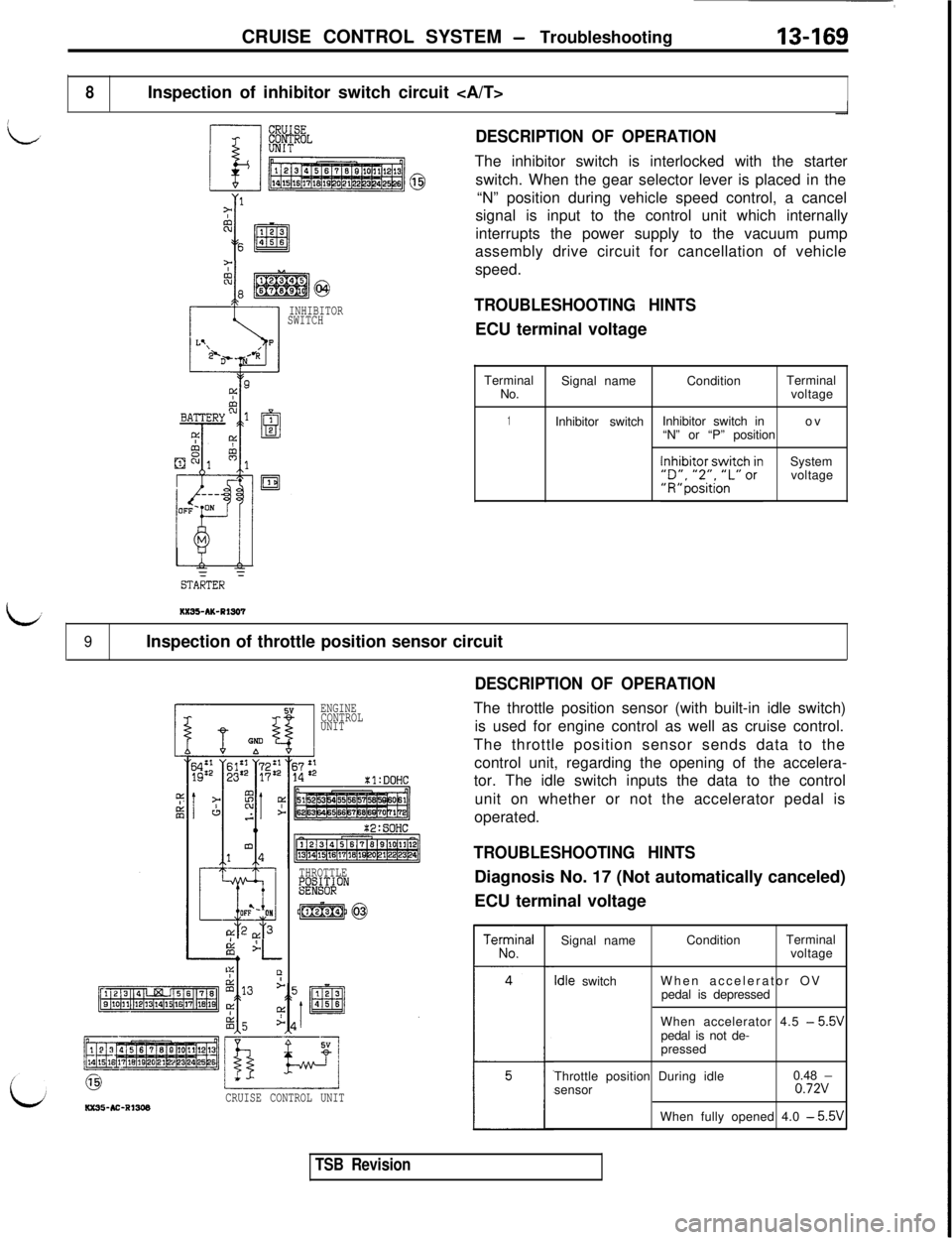
Page 276 of 1146

13-170CRUISE CONTROL SYSTEM - Troubleshooting
10Inspection of circuit associated with accelerator pedal switch OFF function
IGNITlOiiI sw1:
Ind
,277
?IOA-..A-"2Y
.
“3EL
3,"I\-
2
.-----------
E
r
r
g:-1
13--
ii
KH(IG2)
ORi13 : DI
"CLt-t-fi[T
UNIT
DESCRIPTION OF OPERATION‘\JThe accelerator pedal switch is used to detect the
operating state of the accelerator pedal. It is one of
the sensors of the
ELC4A/T automatic transmis-
sion. Since the accelerator pedal is not operated
during vehicle speed control,.the cruise control unit
forces transistor
Tr, into the OFF state, creating the
same state as when the accelerator pedal switch is
placed in the OFF state.
1
$iK&ERATOR
SWITCHH
1
2
-I
CRUISE
CONTROL
UNIT
TROUBLESHOOTING HINTSECU terminal voltage
TerminalNo.Signal name
Condition
3Accelerator pedal switch control
power supplyWhen ignition switch is placed at ON
9Accelerator pedal switchWhen accelerator pedal is depressed
When accelerator pedal is not depressed
System voltage
TSB Revision
Page 277 of 1146
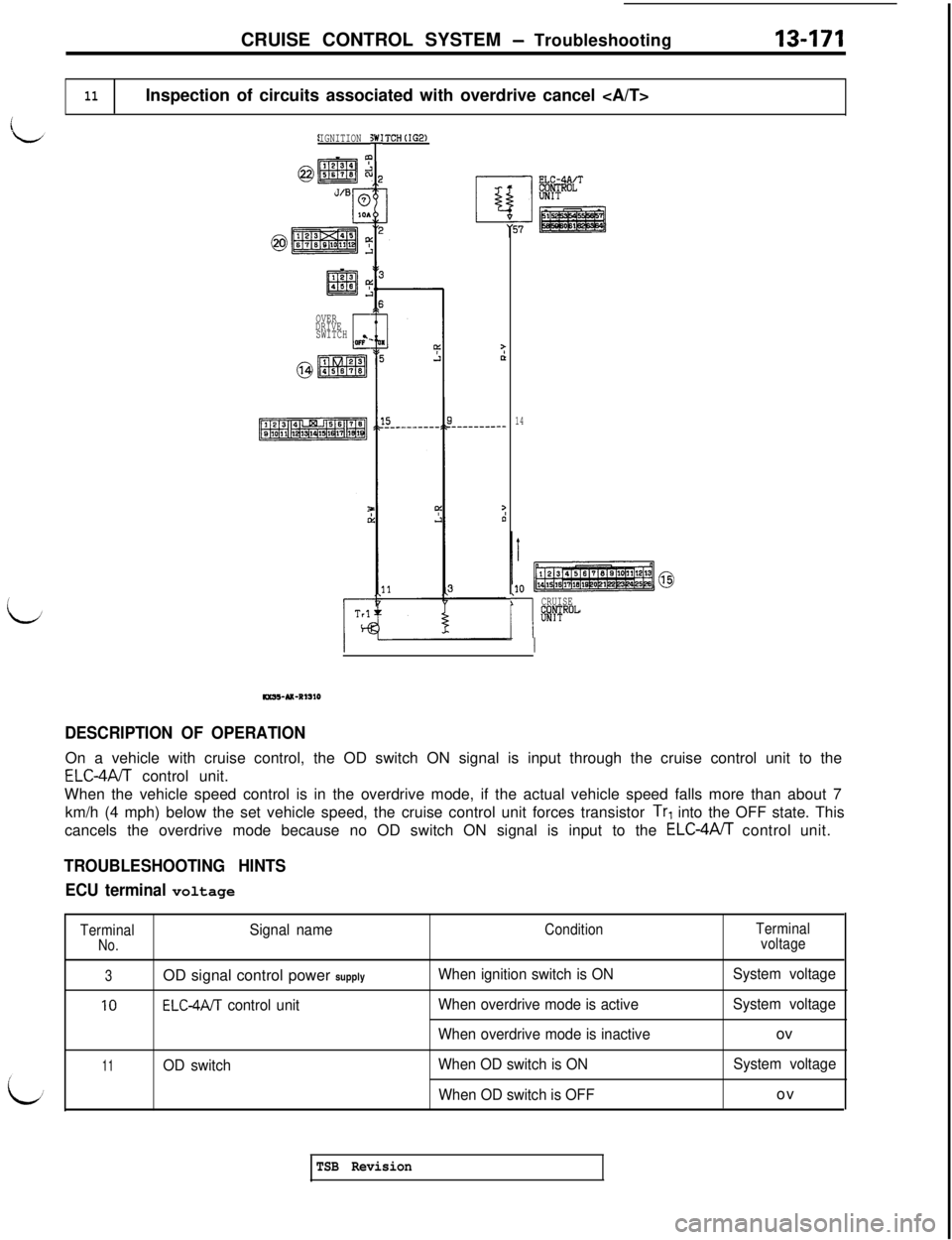
CRUISE CONTROL SYSTEM - Troubleshooting13-171
11Inspection of circuits associated with overdrive cancel
!IGNITION
OVER
DRIVE
SWITCH
C2,
SW1
il-
'TCH(IG2)
14
,lO
l-l
CRUISE
tHTRO"
DESCRIPTION OF OPERATIONOn a vehicle with cruise control, the OD switch ON signal is input through the cruise control unit to the
ELC-4AIT control unit.
When the vehicle speed control is in the overdrive mode, if the actual vehicle speed falls more than about 7
km/h (4 mph) below the set vehicle speed, the cruise control unit forces transistor
Tr, into the OFF state. This
cancels the overdrive mode because no OD switch ON signal is input to the
ELC-4PJT control unit.
TROUBLESHOOTING HINTS
ECU terminal
voltage
TerminalSignal nameConditionTerminal
No.voltage
3OD signal control power supplyWhen ignition switch is ONSystem voltage
10ELC-4A/T control unitWhen overdrive mode is activeSystem voltage
When overdrive mode is inactiveov
11OD switchWhen OD switch is ONSystem voltage
When OD switch is OFFov
TSB Revision
Page 278 of 1146
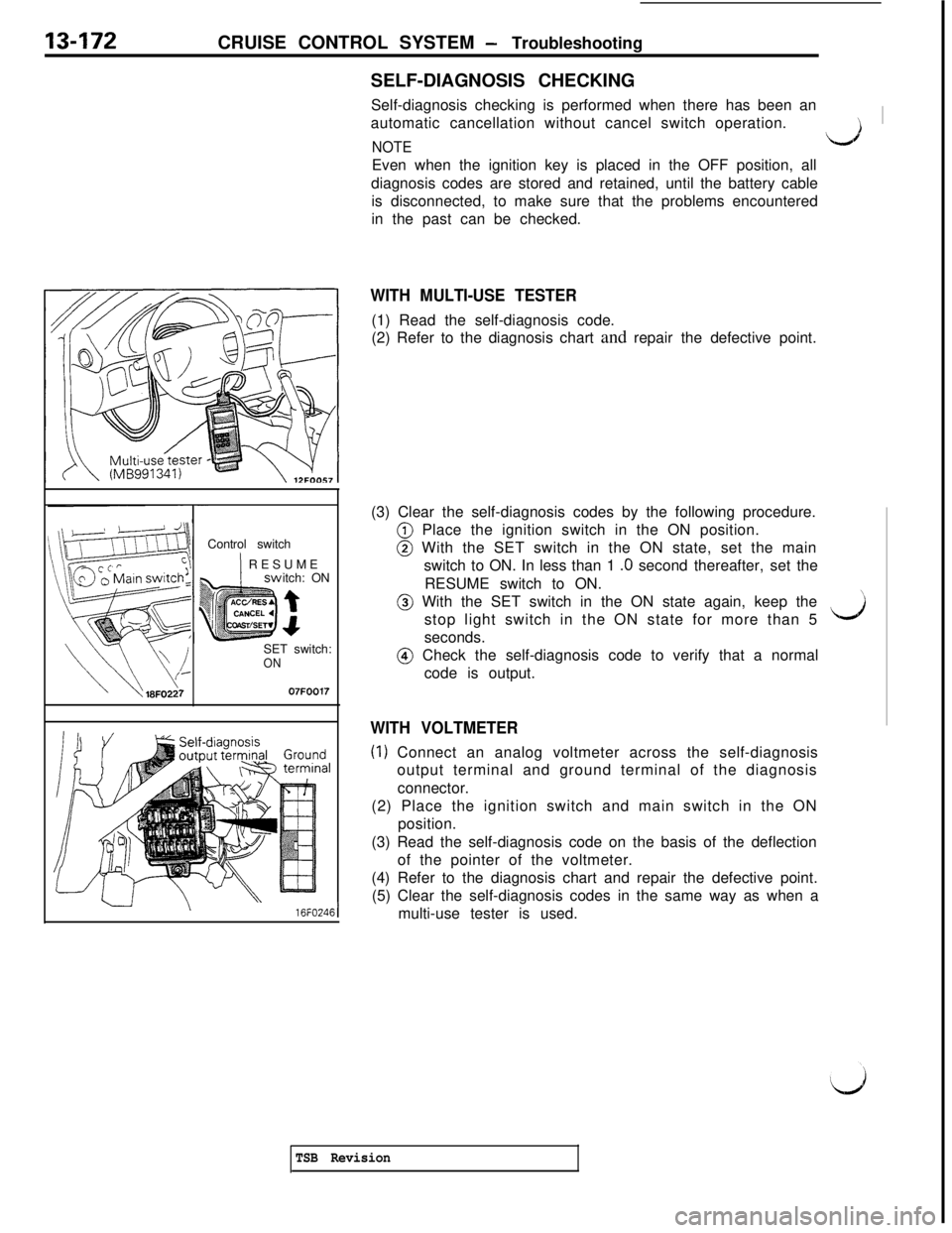
13-172CRUISE CONTROL SYSTEM - Troubleshooting
SELF-DIAGNOSIS CHECKING
Self-diagnosis checking is performed when there has been an
automatic cancellation without cancel switch operation.
‘1 ’
NOTE‘LAEven when the ignition key is placed in the OFF position, all
diagnosis codes are stored and retained, until the battery cable
is disconnected, to make sure that the problems encountered
in the past can be checked.
Control switch
1 RESUME
itch: ON
t
4SET switch:
ON
07FOO17
-\16FO2461
WITH MULTI-USE TESTER(1) Read the self-diagnosis code.
(2) Refer to the diagnosis chart and repair the defective point.
(3) Clear the self-diagnosis codes by the following procedure.@ Place the ignition switch in the ON position.@ With the SET switch in the ON state, set the main
switch to ON. In less than 1
.O second thereafter, set the
RESUME switch to ON.@ With the SET switch in the ON state again, keep the
’stop light switch in the ON state for more than 5dseconds.@ Check the self-diagnosis code to verify that a normal
code is output.
WITH VOLTMETER
(1) Connect an analog voltmeter across the self-diagnosis
output terminal and ground terminal of the diagnosis
connector.
(2) Place the ignition switch and main switch in the ON
position.
(3) Read the self-diagnosis code on the basis of the deflection
of the pointer of the voltmeter.
(4) Refer to the diagnosis chart and repair the defective point.
(5) Clear the self-diagnosis codes in the same way as when a
multi-use tester is used.
TSB Revision
Page 279 of 1146
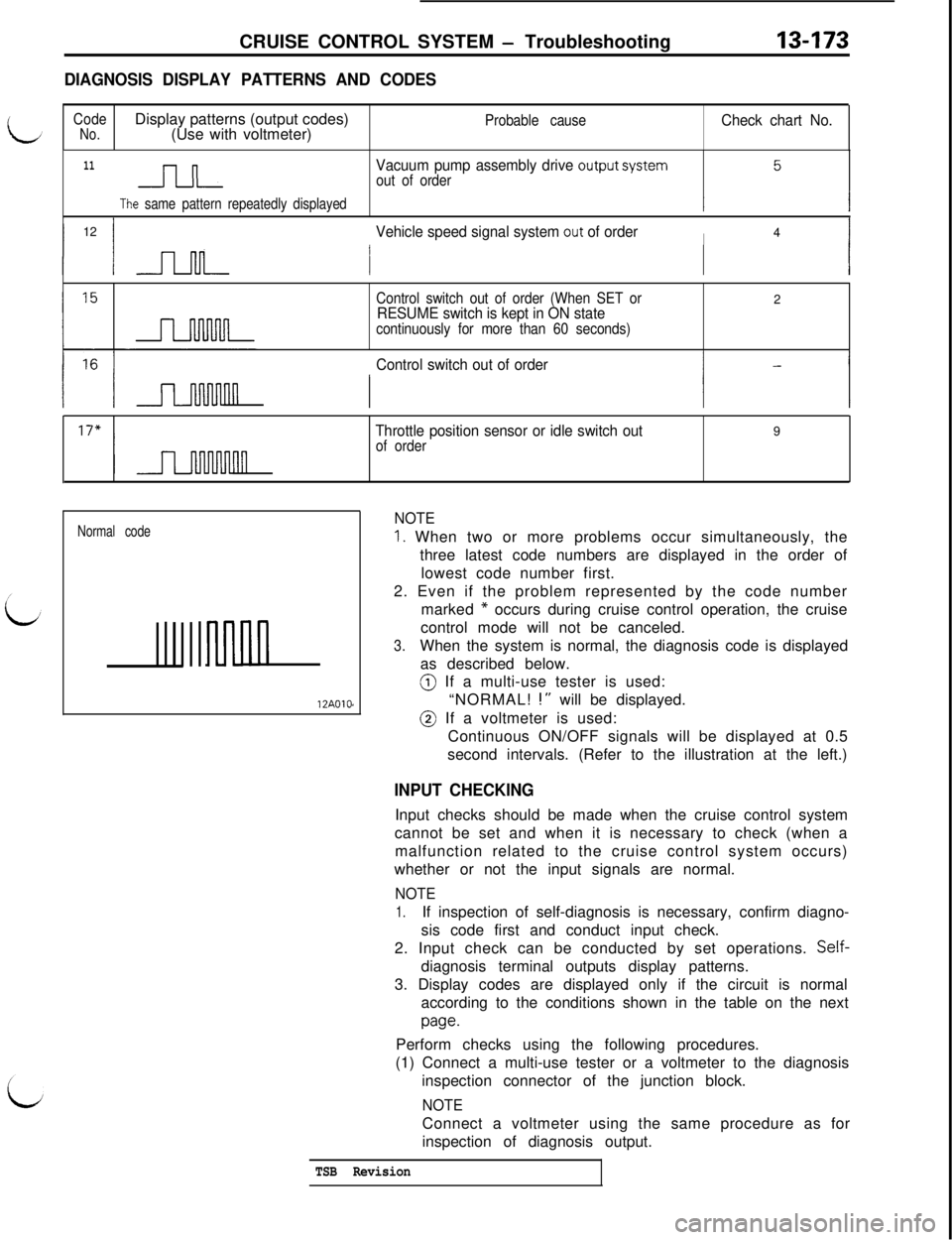
CRUISE CONTROL SYSTEM - Troubleshooting
DIAGNOSIS DISPLAY PATTERNS AND CODES
13473
CodeDisplay patterns (output codes)Probable causeCheck chart No.No.(Use with voltmeter)
11l-l n-JILL
The same pattern repeatedly displayed
Vacuum pump assembly drive output systemout of order5
I I12Vehicle speed signal system out of orderI4I
I In
Control switch out of order (When SET or2RESUME switch is kept in ON statecontinuously for more than 60 seconds)
Control switch out of order
Throttle position sensor or idle switch out9
of order
Normal code
12AOlOa
NOTE
1. When two or more problems occur simultaneously, the
three latest code numbers are displayed in the order of
lowest code number first.
2. Even if the problem represented by the code number
marked * occurs during cruise control operation, the cruise
control mode will not be canceled.
3.When the system is normal, the diagnosis code is displayed
as described below.@ If a multi-use tester is used:
“NORMAL!
! I’ will be displayed.@ If a voltmeter is used:
Continuous ON/OFF signals will be displayed at 0.5
second intervals. (Refer to the illustration at the left.)
INPUT CHECKINGInput checks should be made when the cruise control system
cannot be set and when it is necessary to check (when a
malfunction related to the cruise control system occurs)
whether or not the input signals are normal.
NOTE
1.If inspection of self-diagnosis is necessary, confirm diagno-
sis code first and conduct input check.
2. Input check can be conducted by set operations.
Self-diagnosis terminal outputs display patterns.
3. Display codes are displayed only if the circuit is normal
according to the conditions shown in the table on the next
paw.Perform checks using the following procedures.
(1) Connect a multi-use tester or a voltmeter to the diagnosis
inspection connector of the junction block.
NOTEConnect a voltmeter using the same procedure as for
inspection of diagnosis output.
TSB Revision
Page 280 of 1146
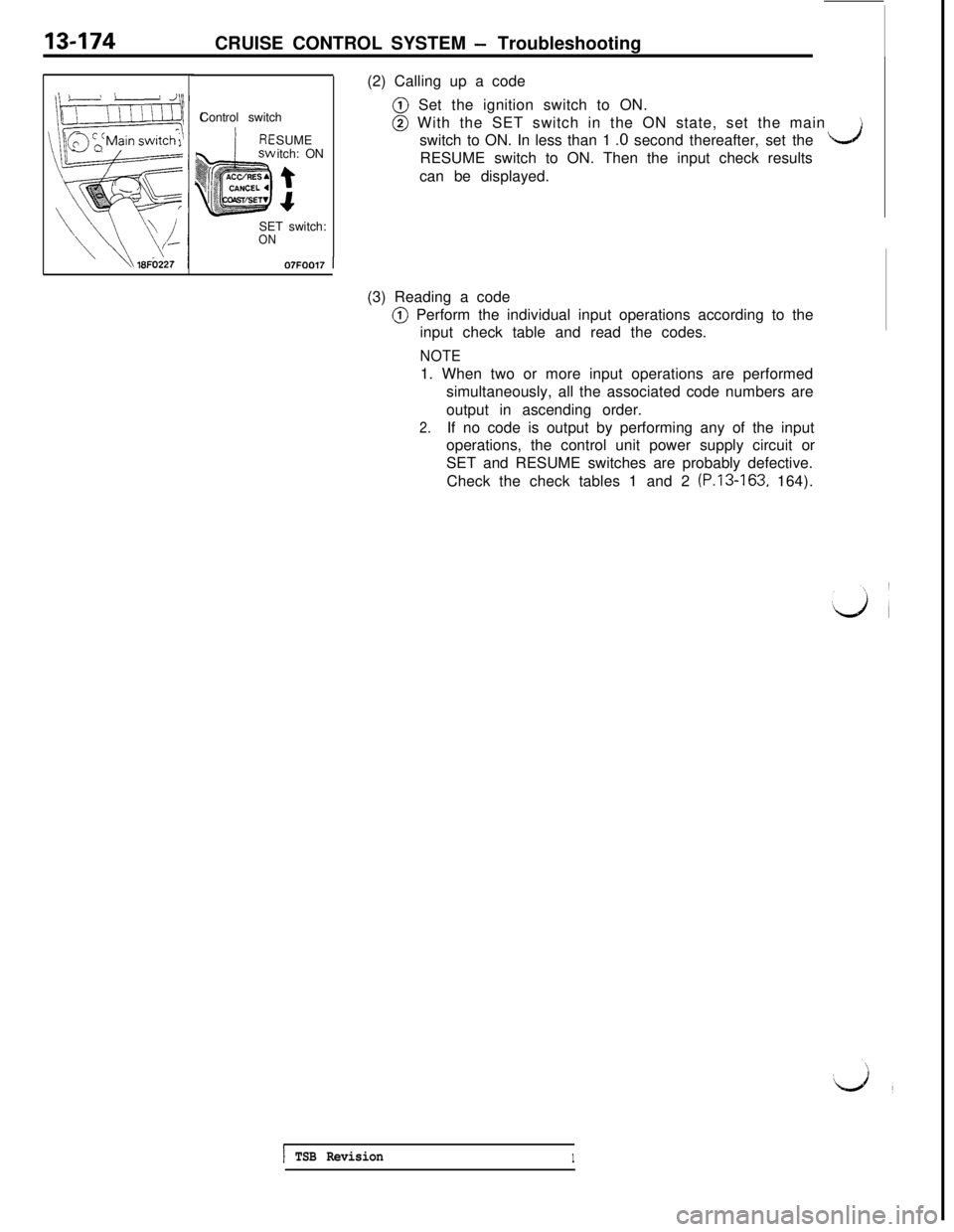
13-174CRUISE CONTROL SYSTEM - Troubleshooting
(2) Calling up a code
Control switch
SUME
itch: ON
t
4SET switch:
ON@ Set the ignition switch to ON.@ With the SET switch in the ON state, set the main
switch to ON. In less than 1
.O second thereafter, set theI,/RESUME switch to ON. Then the input check results
can be displayed.
07FOO17 I(3) Reading a code@ Perform the individual input operations according to the
input check table and read the codes.
NOTE1. When two or more input operations are performed
simultaneously, all the associated code numbers are
output in ascending order.
2.If no code is output by performing any of the input
operations, the control unit power supply circuit or
SET and RESUME switches are probably defective.
Check the check tables 1 and 2
(P.13-163, 164).
1 TSB Revision1